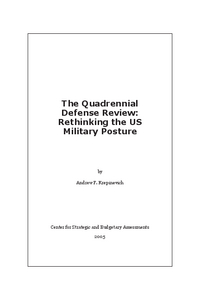
This report provides a point-of-departure framework for developing a post-9/11 defense posture. Its purpose is to assist those charged either with crafting the 2005 Quadrennial Defense Review (QDR) or evaluating it.
Three Enduring Challenges
Recent events have reduced much of the uncertainty under which defense planning occurred in the decade between the Soviet Union’s collapse and the radical Islamist attacks on New York and Washington. The ongoing war against radical Islamists and continued military operations in Afghanistan and Iraq presents America with an immediate and likely enduring challenge to its security. Second, since 1998, the “nuclearization” of Asia has proceeded apace. Both India and Pakistan have detonated nuclear weapons and built nuclear arsenals.
North Korea has declared its possession of nuclear weapons, and Iran has accelerated its efforts to develop a nuclear weapons capability. Finally, China’s continued rise as a great power has yet to be matched by evidence that Beijing will seek to resolve its outstanding strategic objectives through peaceful means. These three enduring security challenges are likely to dominate US defense planning for the next decade or two, and perhaps longer.
The Planning Environment: Key Assumptions
Some assumptions must be made about the geopolitical and military-technical environment in which defense planning occurs. One assumption is that the level of effort required by the US military to secure the nation’s vital security interests is almost certain to increase substantially over the next decade or two, while the emphasis on deterrence will decline in favor of greater relative focus on war-fighting, dissuasion and preemptive/preventive war. Furthermore, it seems reasonable to assume that allies will prove less durable and reliable than during the Cold War era, or even during the recent past. Ironically, the United States will need allies much more than it has over the last 15 years.
Among the key military competitions, the following is assumed:
- The missile/anti-missile competition will continue to favor the offense;
- The stealth/counter-stealth competition will continue to favor the former;
- Detecting and destroying time-sensitive and deep underground targets will remain difficult;
- Enemy attempts to establish sanctuaries against US forces will increase, while the US homeland’s sanctuary status will erode, perhaps precipitously;
- Information warfare operations will not prove decisive at the strategic level of warfare; however, they will prove increasingly important in prevailing at the operational and tactical level of war; and
- Highly distributed, highly networked forces can be fielded in significant numbers.
The Challenges and the Color Plans
The three enduring challenges stated above are captured in Defense Department planning documents for the 2005 QDR, which place them within the following context:
- Catastrophic Challenges to US security, with primary emphasis given to attacks on the US homeland with WMD, especially attacks by nonstate actors.
- Irregular Challenges to US security, such as those posed by terrorist groups and insurgent movements. In the near term, the threat emanates from radical Islamist groups, and from the Taliban and Ba’athist insurgent movements in Afghanistan and Iraq, respectively.
- Disruptive Challenges to US security, which involve dramatic shifts in the character of conflict from that which exists today.The challenge is to hedge against an uncertain future in an environment of dynamic change. Certain hedges, for example, might focus on how the US military would need to adapt if one of the fundamental assumptions concerning the character of key military competitions proved wrong, or on how to meet novel or asymmetric challenges such as those posed by enemies fielding anti-access/area-denial forces—what, in China’s case, might be termed “Assassin’s Mace” capabilities.
- Traditional Challenges to US security that range from the familiar threats posed by combined arms mechanized air-land forces that dominated warfare for much of the 20th century beginning with World War II, and those of nuclear-armed states.
To make informed decisions as to the size and shape of the US military, a set of representative contingencies must be derived from these challenges. The Color Plans employed in this study support the development of a military posture that addresses the full range of plausible threats to US security. The Color Plans examine:
- China (Disruptive Peer) (Plan Yellow)
- North Korea (Nuclear Rogue) (Plan Red)
- Pakistan (Failed Nuclear State) (Plan Green)
- Radical Islam (Plan Purple)
- Global Energy Network Defense (Plan Black)
- Global Commons Defense (Plan Orange)
- Nuclear/Biological Homeland Attack (Plan Blue)



























